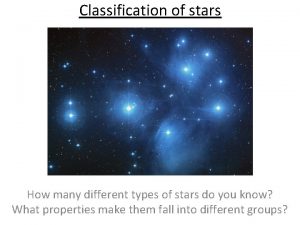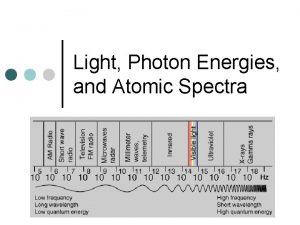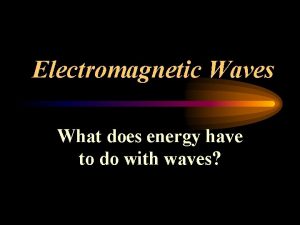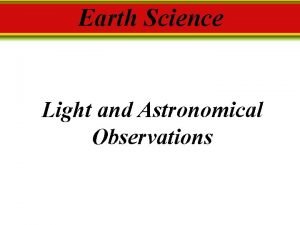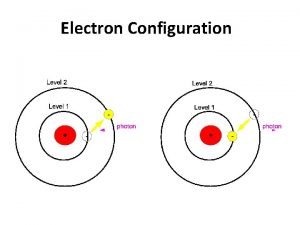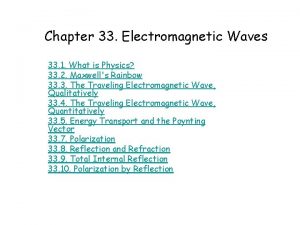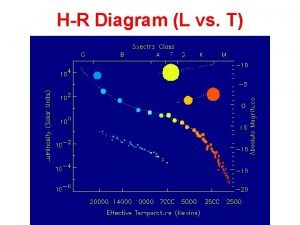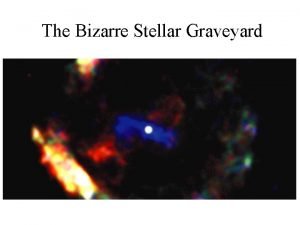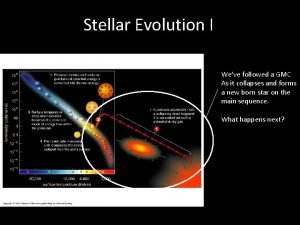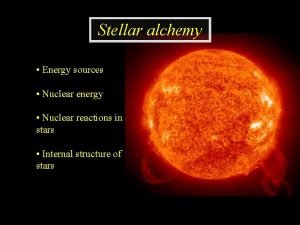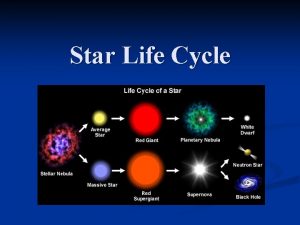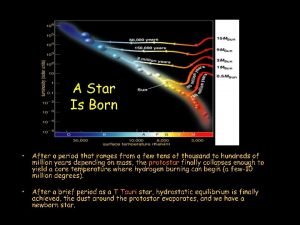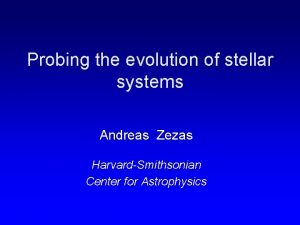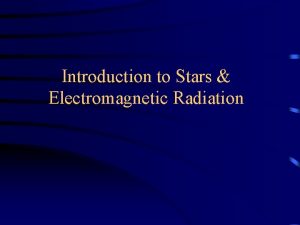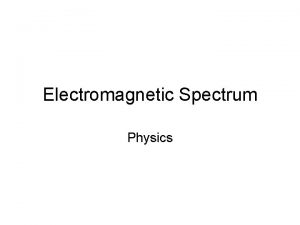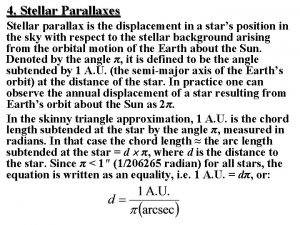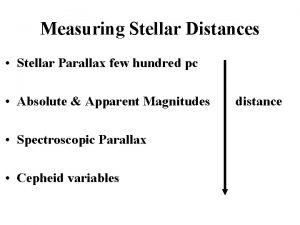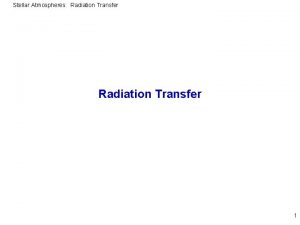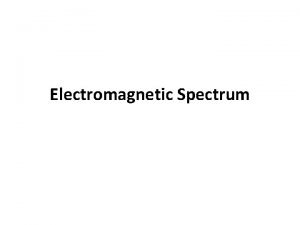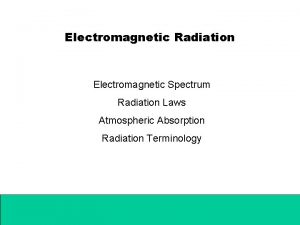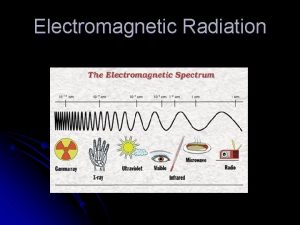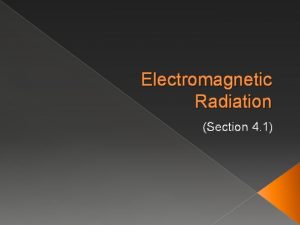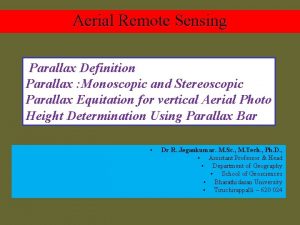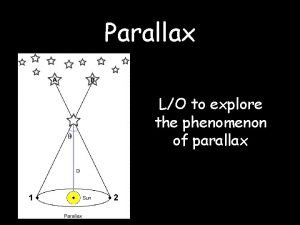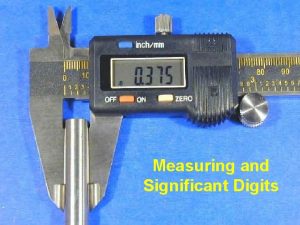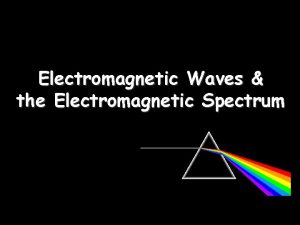Stellar Parallax Electromagnetic Radiation Stellar Parallax Given p



























- Slides: 27

Stellar Parallax & Electromagnetic Radiation

Stellar Parallax • Given p in arcseconds (”), use d=1/p to calculate the distance which will be in units “parsecs” • By definition, d=1 pc if p=1”, so convert d to A. U. by using trigonometry • To calculate p for star with d given in lightyears, use d=1/p but convert ly to pc. • Remember: 1 degree = 3600” • Note: p is half the angle the star moves in half a year

Our Stellar Neighborhood

Scale Model • If the Sun = a golf ball, then – – – Earth = a grain of sand The Earth orbits the Sun at a distance of one meter Proxima Centauri lies 270 kilometers (170 miles) away Barnard’s Star lies 370 kilometers (230 miles) away Less than 100 stars lie within 1000 kilometers (600 miles) • The Universe is almost empty! • Hipparcos satellite measured distances to nearly 1 million stars in the range of 330 ly • almost all of the stars in our Galaxy are more distant

Luminosity and Brightness • Luminosity L is the total power (energy per unit time) radiated by the star, actual brightness of star, cf. 100 W lightbulb • Apparent brightness B is how bright it appears from Earth – Determined by the amount of light per unit area reaching Earth – B L / d 2 • Just by looking, we cannot tell if a star is close and dim or far away and bright

Brightness: simplified • 100 W light bulb will look 9 times dimmer from 3 m away than from 1 m away. • A 25 W light bulb will look four times dimmer than a 100 W light bulb if at the same distance! • If they appear equally bright, we can conclude that the 100 W lightbulb is twice as far away!

Same with stars… • Sirius (white) will look 9 times dimmer from 3 lightyears away than from 1 lightyear away. • Vega (also white) is as bright as Sirius, but appears to be 9 times dimmer. • Vega must be three times farther away • (Sirius 9 ly, Vega 27 ly)

Distance Determination Method • Understand how bright an object is (L) • Observe how bright an object appears (B) • Calculate how far the object is away: B L / d 2 So L/B d 2 or d √L/B

Homework: Luminosity and Distance • Distance and brightness can be used to find the luminosity: L d 2 B • So luminosity and brightness can be used to find Distance of two stars 1 and 2: d 21 / d 22 = L 1 / L 2 (since B 1 = B 2 ) i. e. d 1 = (L 1 / L 2)1/2 d 2

Homework: Example Question • Two stars -- A and B, of luminosities 0. 5 and 2. 5 times the luminosity of the Sun, respectively -- are observed to have the same apparent brightness. Which one is more distant? • Star A • Star B • Same distance

Homework: Example Question • Two stars -- A and B, of luminosities 0. 5 and 2. 5 times the luminosity of the Sun, respectively -- are observed to have the same apparent brightness. How much farther away is it than the other? • LA/d 2 A = BA =BB = LB/d 2 B d. B = √LB/LA d. A • Star B is √ 5=2. 24 times as far as star A

“Light” – From gamma-rays to radio waves • The vast majority of information we have about astronomical objects comes from light they either emit or reflect • Here, “light” stands for all sorts of electromagnetic radiation • A type of wave, electromagnetic in origin • Understanding the properties of light allows us to use it to determine the – temperature – chemical composition – (radial) velocity of distant objects

Waves • Light is a type of wave • Other common examples: ocean waves, sound • A disturbance in a medium (water, air, etc. ) that propagates • Typically the medium itself does not move much

Wave Characteristics • Wave frequency: how often a crest washes over you • Wave speed = wavelength ( ) frequency (f)

Electromagnetic Waves • Medium = electric and magnetic field • Speed = 3 105 km/sec

Electromagnetic Spectrum Energy: low medium high

Electromagnetic Radiation: Quick Facts • There are different types of EM radiation, visible light is just one of them • EM waves can travel in vacuum, no medium needed • The speed of EM radiation “c” is the same for all types and very high ( light travels to the moon in 1 sec. ) • The higher the frequency, the smaller the wavelength ( f = c) • The higher the frequency, the higher the energy of EM radiation (E= h f, where h is a constant)

Visible Light • Color of light determined by its wavelength • White light is a mixture of all colors • Can separate individual colors with a prism

Three Things Light Tells Us • Temperature – from black body spectrum • Chemical composition – from spectral lines • Radial velocity – from Doppler shift

Temperature Scales Fahrenheit Centigrade Kelvin 459 ºF 273 ºC 0 K 32 ºF 0 ºC 273 K Human body temperature 98. 6 ºF 37 ºC 310 K Water boils 212 ºF 100 ºC 373 K Absolute zero Ice melts

WUP: What is the Blackbody Curve and how does it depend on temperature? • jj: The blackbody curve describes the distribution of reemitted radiation from a blackbody (an object that absorbs and reemits all radiation falling upon it. The peak of the frequency on a blackbody curve is directly proportionate to to the temperature. • K: Blackbody curve is an idealized body that absorbs all electromagnetic radiation. It needs to remain at a constant temperature but the spectrum is determined by the temperature alone. As the temperature decreases so does the intensity and its peak will move to a longer wavelength.

Black Body Spectrum • Objects emit radiation of all frequencies, but with different intensities Ipeak Higher Temp. Ipeak Lower Temp. fpeak<fpeak

Cool, invisible galactic gas (60 K, fpeak in low radio frequencies) Dim, young star (600 K, fpeak in infrared) The Sun’s surface (6000 K, fpeak in visible) Hot stars in Omega Centauri (60, 000 K, fpeak in ultraviolet) The higher the temperature of an object, the higher its Ipeak and fpeak 14

Wien’s Law • The peak of the intensity curve will move with temperature, this is Wien’s law: Temperature * wavelength = constant = 0. 0029 K*m So: the higher the temperature T, the smaller the wavelength, i. e. the higher the energy of the electromagnetic wave

Example • Peak wavelength of the Sun is 500 nm, so T = (0. 0029 K*m)/(5 x 10 -7 m) = 5800 K • Instructor temperature: roughly 100 °F = 37°C = 310 K, so wavelength = (0. 0029 K*m)/310 K = 9. 35 * 10 -6 m = 9350 nm infrared radiation ≈ 10 μm = 0. 01 mm

Measuring Temperatures • Find maximal intensity Temperature (Wien’s law) Identify spectral lines of ionized elements Temperature

Color of a radiating blackbody as a function of temperature • Think of heating an iron bar in the fire: red glowing to white to bluish glowing
 What is stellar parallax?
What is stellar parallax? Intensity of electromagnetic radiation
Intensity of electromagnetic radiation When electromagnetic radiation of wavelength 300
When electromagnetic radiation of wavelength 300 Facts about electromagnetic radiation
Facts about electromagnetic radiation Which telescope detects invisible electromagnetic radiation
Which telescope detects invisible electromagnetic radiation Em waves
Em waves Electromagnetic wavelength formula
Electromagnetic wavelength formula Sound waves are longitudinal waves true or false
Sound waves are longitudinal waves true or false Types of radiation in the electromagnetic spectrum
Types of radiation in the electromagnetic spectrum Wavelength chart
Wavelength chart Intensity em wave
Intensity em wave Mizar luminosity
Mizar luminosity Stellar formation
Stellar formation Masses in the stellar graveyard
Masses in the stellar graveyard Stellar evolution
Stellar evolution Stellar alchemy
Stellar alchemy Stellar saga
Stellar saga Stellar evolution diagram
Stellar evolution diagram Stellar asset management
Stellar asset management Stellar evolution lab the life cycle of a star
Stellar evolution lab the life cycle of a star Stellar evolution
Stellar evolution Stellar evolution
Stellar evolution Stellar motion matlab
Stellar motion matlab Stellar evolution diagram
Stellar evolution diagram Stellar evolution
Stellar evolution Iptv hosting
Iptv hosting Atmospheric heaven
Atmospheric heaven Stellar
Stellar
